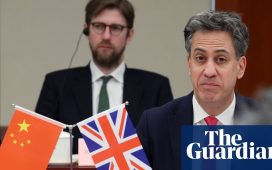Receive free UK energy updates
We’ll send you a myFT Daily Digest email rounding up the latest UK energy news every morning.
We all have weeks where, despite our best efforts, it doesn’t feel like we’ve accomplished very much.
Take heart. Over a decade of efforts to revitalise the market for household energy has achieved remarkably little — various reforms, inquiries, a price cap and a great big crisis later.
In late 2013, as regulator Ofgem set about another round of changes to boost competition, the Big Six energy retailers had about 95 per cent of the electricity market. The rest was shared between a couple of growing rivals, plus a clutch of small suppliers that had under 2 per cent of the market between them. There were 24 companies operating across gas and electricity.
The ill-advised push to get customers to switch to cut-price deals offered by flimsy new entrants would peak with 70 suppliers and a Big Six market share in electricity of under 70 per cent, just before names like SSE and Npower left the retail market.
We’ve now come full circle. There were 21 suppliers across the market, as of March. After Octopus’s deal this month to buy Shell’s household supply business, the new Big Six — comprising legacies Centrica, EDF, Eon, Scottish Power plus newbies Octopus and Ovo — have more than 90 per cent of the electricity market. After multiple failures, at a substantial cost to bill payers, there are about three competitors of any note and a clutch of smaller suppliers with under 2 per cent of the market.
Today’s market risks falling short in terms of competition, innovation and fairness, issues that are interrelated. And the thinking on what to do about that is in its infancy.
There is little meaningful competition in the retail market. The fixed-price deals available are generally limited to existing customers. Pricing is clustered close to the regulatory price cap, now £2,074. Switching, the key competition metric for the past decade, has evaporated — down 70 per cent on pre-crisis levels. Most of the switching that is happening is going towards the bigger suppliers, not away from them.
In the absence of price competition, companies could try to outdo each other on innovative offerings or customer service — and that has started with the new cast of characters within the Big Six. “Companies like Octopus and Ovo have brought more innovation to the market than the previous incumbents,” said Alasdair Dorrat, partner at Baringa. “But with higher barriers to entry and tightly regulated margins, the question is where the next generation of innovators will come from.” Octopus’s influence is such that its Kraken technology, sold to rivals, will soon underpin half of households’ electricity supply.
The underlying problem is that the entire market design and regulation was geared towards price competition, rather than anything else. Big hub suppliers must provide a universal service, while taking on various social policy responsibilities like the “warm home discount” on winter fuel bills. The price cap — a blunt instrument that in a world of higher energy costs provides too much support to households and too little to others — in effect forces companies to pursue much the same supply and trading strategies.
A government call for evidence (or a plea for ideas) on how to boost innovation closes on Monday. It rules out any near-term radical change to the role of suppliers in the market, in part because big companies are useful in projects like the rollout of smart meters.
A forthcoming paper by Adam Bell at consultancy Stonehaven argues fresh thinking is needed to encourage competition and the emergence of new business models. That includes actually hitting the latest deadlines to move the market on to near-real-time billing for actual usage, rather than estimated consumption, something that would unlock more differentiated products. The ability to split a household’s suppliers could enable new entrants to offer bespoke packages for just, say, car charging. Such asset-specific or time-of-use tariffs will require a rethink of the price cap, argues Bell. Fairness, in any case, needs more attention in a world where the wealthier increasingly electrify and consume energy when prices are lower, while others can’t.
One thing seems clear: 10 years of effort has left the UK with a one-size-fits-all energy market that is no longer fit for purpose.











